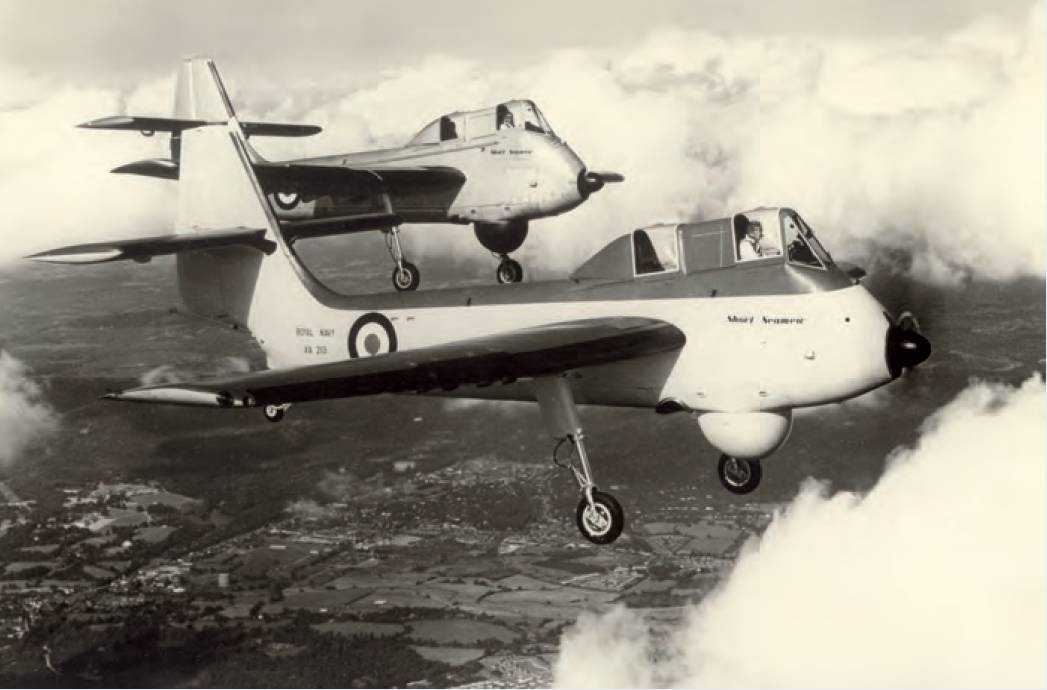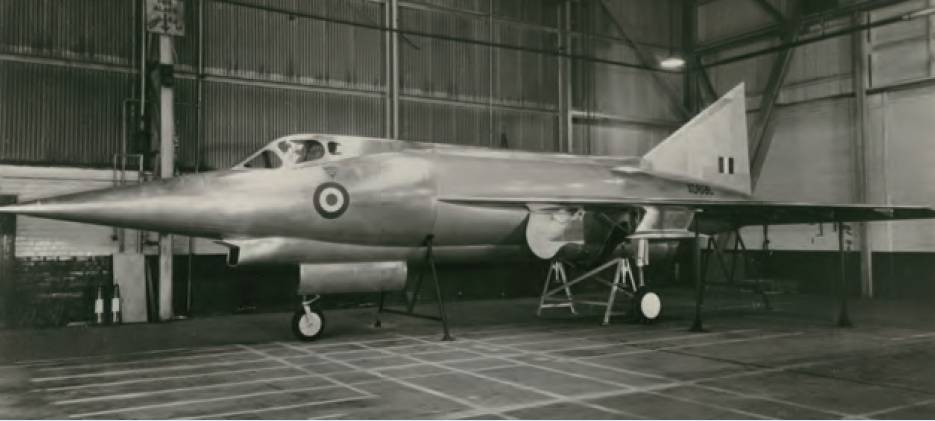Weybridge branche
WEYBRIDGE BRANCH
The 1957 Defence White Paper Cancelled Projects
On 20 April the well-known aviation writer, Tony Buttler, came to Brooklands to talk to the Weybridge Branch on the ‘infamous’ 1957 Defence White Paper (DWP). For 20 years Tony worked as a metallurgist at High Duty Alloys where his interest in military aircraft design and development grew. In 1994 he took a Masters Degree in Information Science and Archives at Loughborough University and became a full-time aviation historian, author and lecturer. With dozens of books and hundreds of articles for historical aviation magazines to his credit, in 2017 he became a member of the Royal Aeronautical Society Historical Group Committee.
 Two Short SB.6 Seamews. RAeS/NAL.
Two Short SB.6 Seamews. RAeS/NAL.
The 1957 DWP announced the decision to abandon the future development of new manned fighter aircraft for the UK. It was prepared by the then Minister of Defence Duncan Sandys. He became an MP in 1935 and during 1944 he was chairman of a War Cabinet Committee for defence against German flying bombs and rockets (the V1 and V2). When the Conservatives regained power in 1951, Sandys was made Minister of Supply and then, in 1957, as Minister of Defence, he wrote his DWP, Defence – an Outline of Future Policy. This was based on the findings of a Government Working Party on Air Defence which concluded that the main threats to the UK would be bombardment by nuclear Intermediate Range Ballistic Missiles, Mach 2-5 bombers flying at up to 70,000ft, low-level subsonic bombers and uncrewed supersonic aircraft.
The White Paper declared: “Work will proceed on the development of a ground-to-air missile defence system which will, in due course, replace the manned aircraft of Fighter Command. The government has come to the conclusion that the RAF are unlikely to have a requirement for fighter aircraft of types more advanced than the supersonic P1, and work on such projects will stop.”
The speaker went on to look at the projects affected by this decision starting with three which were not cancelled by the DWP but which many publications say were, often to imply that the DWP was more damaging than it really was. These three projects had already gone by the time Sandys began work on his White Paper; none of them flew.
Firstly, the Hawker P.1083 for which the full goahead was given by the Ministry in December 1951 as a development of the Hunter with 50° swept wing and armed just with guns. In April 1953, well into manufacture, the Air Staff requested that the P.1083 should be rearmed with the Blue Jay missile (de Havilland Firestreak) as its primary weapon, which created problems of lack of space for the system leading to official cancellation in June 1953. The prototype airframe, due to fly later that year, was completed as the prototype Hunter F.6 with the 200-Series Avon.
The Supermarine 545 was originally proposed as a 50° swept-wing development of the Swift but, as built, it featured a crescent wing. Go-ahead was given in 1952 but by 1954 the need for the aircraft was being questioned and it was terminated in December 1955, largely to conserve funds for other projects.
WORK WILL PROCEED ON THE DEVELOPMENT OF A GROUND-TO-AIR MISSILE DEFENCE SYSTEM WHICH WILL, IN DUE COURSE, REPLACE THE MANNED AIRCRAFT OF FIGHTER COMMAND
The first thin-wing Javelin project was drawn in July 1953. Subsequently, larger engines were proposed, strength factors were raised and the equipment requirements altered leading to a new aircraft of only Javelin layout. In Washington in December 1955, Minister of Supply Reginald Maudling, learned about the secret Avro Canada CF-105 Arrow fighter. A UK evaluation team went to Canada in 1956 to assess that project for potential use with the RAF. The Arrow, from a firm within the Hawker Siddeley Group, clearly had a far superior performance. The thin-wing Javelin was out of date and so was cancelled in May 1956.
Next Tony addressed the Avro 730 which started in response Specification R.156T and Operational Requirement OR.330 in 1955 for a Mach 2.5 high-altitude reconnaissance aircraft. The Avro 730 was the winner and a prototype was ordered in late 1955. However, in view of the increasing capacity of the Soviet defensive systems, it was eventually concluded that the 730 could not survive and OR.336 was cancelled in April 1957 along with the Avro 730 and its stand-off nuclear weapon, Blue Rosette.
Britain’s rocket fighter programme began in 1952 with Specification F.124T. Selected for prototype construction were the Avro 720 and Saro SR.53, both of which were to have a mixed jet/rocket power plant. These were viewed as demonstrators. Developed versions of both were subsequently proposed but only the Saro P.177 (or SR.177) was accepted since it was considered superior to the Avro 720 which was cancelled in April 1955 pre the DWP, before it had flown. The SR.177 was to have served with both the RAF and the RN (there was also German interest) – this was a big programme. However, cancellation came as a result of the DWP in June 1957.

The English Electric Lightning’s development was curtailed or delayed quite considerably by the DWP plan which was for it to fill the gap in the short term until the service arrival of guided missiles.
The Short Seamew is the forgotten victim of the 1957 cuts. In 1950 a small lightweight anti-submarine aircraft was considered ideal to complement the larger Fairey Gannet and Specification M.123 was raised to cover it. The winning design was the Short SB.6 (Seamew) and the first example flew in August 1953, only to be plagued with handling problems. A batch was ordered for the Navy and RAF Coastal Command but the 1957 DWP disbanded the RNVR’s Air Branch altogether, which brought cancellation of the Seamew order with it.
Spec F.155T raised in early 1955, for a longrange very advanced all-weather interceptor capable of destroying enemy raiders operating at 60,000ft and Mach 1.3, brought proposals from Armstrong Whitworth, Vickers-Supermarine, Hawker, SaundersRoe, English Electric and de Havilland. The winner was the Fairey ‘Delta 3’, a substantial enlargement and development of the world speed recordbreaking Delta 2, weighing over 50,000lb. Duncan Sandys cancelled Specification F.155 just a few days before the White Paper was released, though the prototype FD3s had not yet been ordered.
THE ONLY WAY TO STOP AN ATTACK WOULD BE TO STOP IT FROM BEING LAUNCHED, AND THE ONLY WAY TO DO THAT WAS THROUGH DETERRENCE
One more British project badly hit by the DWP was the Hawker P.1121, developed from Hawker’s F.155T long-range interceptor proposal, the P.1103, eliminated because it was too small. However, Hawker decided to continue its development. It was revived in early 1956 as the P.1116 Mach 2 interceptor and long-range strike fighter, and then refined in June 1956 as the P.1121 Mach 2 air superiority strike fighter.
Hawker Siddeley eventually financed the project as a private venture but some within the Air Staff were amazed by this decision because the basic configuration had been rejected in the P.1103. In particular, it was not looked upon by the Air Staff as a complete weapon system and it was considered that Hawker had yet to grasp the weapon system concept. The P.1121 was to be powered by a single DH Gyron and armed with Red Top missiles, rockets and Aden cannon; it was expected to reach Mach 1.35 at sea level and 2.35 at height.
In January 1957 Hawker was told that the Ministry was not interested in ordering the P.1121, but a full-scale mock-up was completed soon afterwards. The 1957 DWP then killed any hopes of a home order, and in September the Hawker Siddeley board agreed to continue with the P.1121 but at a much-reduced rate of expenditure and the project fizzled out in 1958. It is wrong to say that the P.1121 was cancelled by the 1957 DWP because it was never ordered but the new policy certainly blocked any hopes for future procurement.
The P.1121 was replaced at Hawker by the P.1127 V/STOL aircraft which was developed into the Harrier. It could be said that the P.1127 was the most positive outcome of the events brought about by the 1957 DWP.
Two jet engine programmes, both in the 20,000lb thrust class and both intended specifically for Mach 2 fighters, were also abandoned because of the White Paper – the Rolls-Royce RB106, possibly to be called the Thames, and the DH Gyron. Both had received Ministry sponsorship.
The introduction of strategic nuclear missiles seriously upset the nature of the UK’s defensive posture, and some planners concluded that no effective defence against these weapons was possible. The only way to stop an attack would be to stop it from being launched, and the only way to do that was through deterrence. Although the survival of the V-Force was required, the need for air defence using fighters was essentially eliminated.
The speaker went on to discuss the effects of the DWP on missile development, and the government’s realisation that manned fighters had uses other than intercepting bombers, which led to AST.403 and the Eurofighter Typhoon.
The vote of thanks was given by Allan Winn, retired Director of the Brooklands Museum.
Chris Farara
 Two Short SB.6 Seamews. RAeS/NAL.
Two Short SB.6 Seamews. RAeS/NAL.